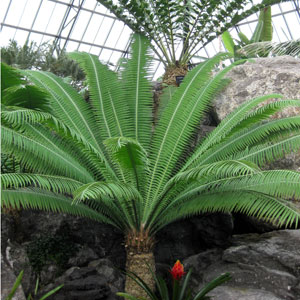How amazing it is! Let’s discover below amazing cycads facts for kids
- Size of cycads depends on the species. They can reach few inches or several feet in the height.
- Cycads have cylindrical woody stem without branches. Stem is covered with corky bark.
- Crown consists of large, hard and elongated leaves that grow straight from the stem. Leaves are arranged in the form of rosette. New leaves appear in the center of the crown. Cycads have either pinnate (feathery) or deeply cut evergreen leaves. This might
be one of the most weird facts about them.
- Certain types of cycads shed their leaves during extremely hot and dry season.
- Some species of cycads look like palm trees, while others look like ferns at the first glance. Despite similarities in morphology, cycads, palms and ferns are not genetically related.
- Cycads live in symbiosis (mutual beneficial relationship) with cyanobacteria which are able to fixate atmospheric nitrogen. These bacteria produce neurotoxin that can be found in various parts of the plant, including the seeds.
- Cycads do not produce flowers. Male and female reproductive organs develop on separate plants (dioecious). Male plants produce egg-shaped cones that are usually yellow to brown in color. Female plants develop ovules and seeds on leafy structures called sporophylls.
- Wind and beetles are in charge for the pollination. Cycads produce specific smell which attracts beetles and ensures successful pollination. Still boring? Check out our funny images to get relaxing
moments in your freetime.
- Cycads produce small seeds that are covered with yellow or reddish flesh. Even though seeds contain toxin, they are used in human diet in some parts of the world.

- Cycads can be cultivated as houseplants. They can be propagated via seed or tissue cuttings.
- Cycads are source of food for many animals. Larvae of certain butterflies and ants eat secretion from the leaves, cattle feeds on the leaves, while fruit bats eat seeds.
- Cycads were used for the production of flour in the 9th century in India.
- Certain types of cycads are known as bread trees because they contain starch which is important part of diet of indigenous people.
- Leaves and cones of cycads are used in traditional Asian medicine.
- Most cycads grow slowly, but they can survive over 1000 years in the wild.
If you have a keen interest in amazing
science facts, keep subcribing
our site to get more information about this aspect.

Không có nhận xét nào:
Write nhận xét